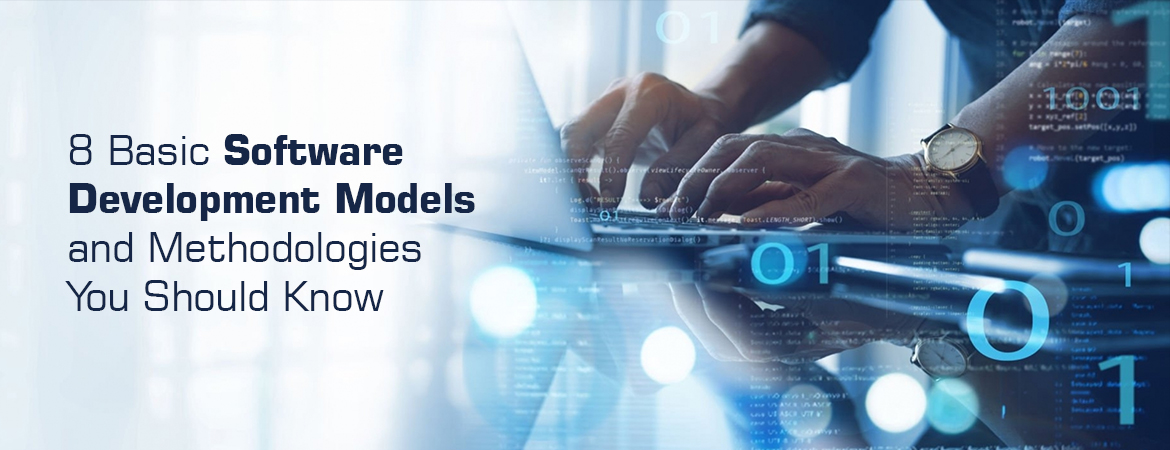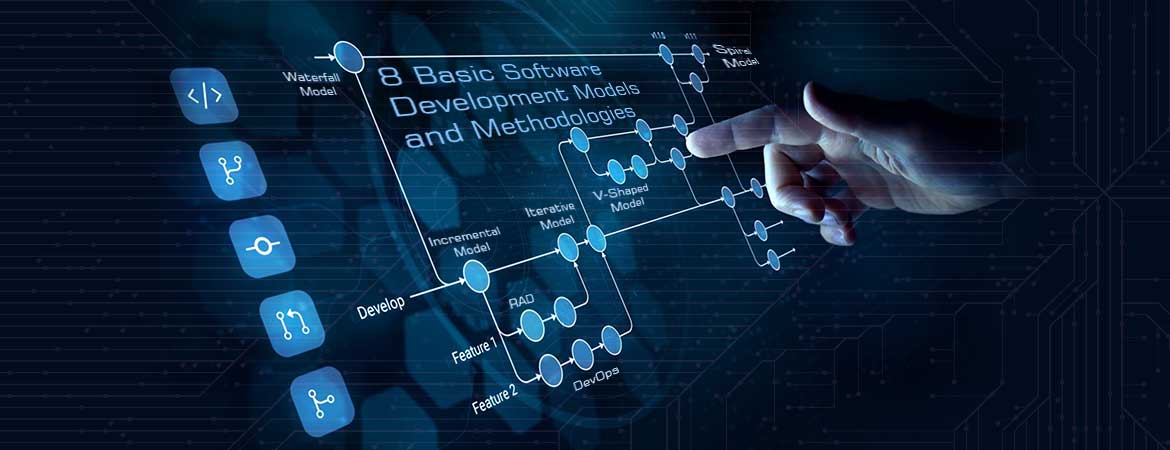
We use cookies to ensure that we give you the best experience on our website.
By using this site, you agree to our use of cookies. Find out more.
This blog will cover 8 basic software development life cycle models and methodologies that every budding developer and organization should understand. We will discuss the core concepts, processes, benefits, and drawbacks of these models within the context of the software development life cycle.

Choosing the right software development life cycle model is essential for any Mobile App Development Company or software development team to deliver high-quality products on time and within budget. There are numerous methodologies to choose from, each with its strengths, weaknesses, and suitability for different types of projects. This blog will cover 8 basic software development life cycle models and methodologies that every budding developer and organization should understand. We will discuss the core concepts, processes, benefits, and drawbacks of these models within the context of the software development life cycle.

Understanding the differences between these methodologies will help you determine which approach is best for your projects based on factors like requirements, timelines, and team culture. Learning the fundamentals of these software development life cycle models is an essential first step on your software development journey.
The Waterfall Model is a linear and sequential software development process where progress flows in a step-by-step fashion from analysis through design, implementation, testing, and deployment. It is the oldest and most basic software development life cycle model. In the Waterfall Model, each phase must be completed fully before the next phase can begin. The main advantages are its structured nature and clear goals for each phase.
However, it lacks the flexibility to make changes once a phase is completed. Any updates require moving back through phases, which is time-consuming and expensive. The Waterfall Model works best for well-defined projects with stable requirements and minimal changes. However, for most modern software projects, a more iterative approach like the Agile Model is preferable to enable rapid responses to changing needs and frequent releases of refined software. It results in higher customer satisfaction at lower costs and in less time.
The Agile Methodology is an iterative and incremental software development model that focuses on flexible responses to change, frequent delivery of working software, and continuous development within self-organizing cross-functional teams. In contrast to traditional plan-driven software development models like the Waterfall Model, Agile embraces adaptive planning, evolutionary development, early delivery, and continuous improvement. Popular Agile frameworks include Scrum, XP, and Kanban. The main benefits of Agile are faster time to market, increased flexibility and productivity, higher team morale, and earlier discovery of defects.
Agile also requires organizational changes and adaptability from teams to work without extensive upfront planning. Agile is well suited for projects where requirements are uncertain and likely to change, time to market is critical, and there is value in delivering working software iteratively. Within the software development models, Agile offers a balanced approach between structure and flexibility to adapt software development to the rapidly changing needs of modern businesses.
The Iterative Model is a type of incremental software development life cycle model that involves repeating cycles of analysis, design, implementation, and testing. While similar to Agile methodology, the Iterative Model is generally less formal and structured. The software development process starts with initial planning followed by an iteration that involves designing, developing, and testing an initial version of the software to identify and fix defects. Subsequent iterations incorporate additional features based on feedback, with each iteration repeating all phases until the final product is ready.
The main benefit of the Iterative Model is being able to incorporate changes easily at the start of each iteration. Short iterations also allow early detection of issues. However, the Iterative Model can be time-consuming and difficult to plan since each iteration repeats all phases. The Iterative Model works best for medium to large projects where requirements are still evolving and an incremental approach helps gradually refine the product. Regular scoping and planning are needed to control scope creep within iterations.
The Spiral Model is a risk-driven software development life cycle model where iterations are represented as loops in a spiral. Each loop consists of four phases: planning, risk analysis, engineering, and evaluation. The Spiral Model starts by identifying objectives, constraints, and alternatives. Then a prototype is developed while assessing and mitigating risks. This risk analysis drives the spiral cycles with each iteration producing more refined deliverables. The iterations continue until acceptable risks and costs are achieved. The main benefits of the Spiral Model are its focus on risk analysis to manage project scope and costs.
By identifying and addressing risks early, significant changes late in development can be avoided. However, the Spiral Model can be complex to implement due to its emphasis on risk management. The Spiral Model works best for large projects with uncertain requirements and risks. Providing early prototypes helps stabilize requirements while assessing the risks of new approaches. The risk-driven nature balances flexibility and control of scope, schedule, and costs.
The V-Shaped Model is a software development life cycle model that emphasizes testing and verification. As the name implies, the process has a V shape where development flows down one side and testing mirrors it up the other side. The left side of the 'V' represents sequential software development phases from requirements to coding. The right side represents corresponding testing phases from unit testing to validation testing. The main benefit of the V-Model is its emphasis on early testing to find and fix defects as early as possible.
However, the extensive testing efforts make the V-Model resource-intensive. The V-Model is best suited for projects where quality and early verification take priority over timeline and budget. By testing at each phase and fixing defects early, fewer issues are found later, minimizing rework and costs. The V-Shaped Model follows a systematic approach to ensure thorough testing at each stage. However, an Agile approach may enable quicker iterations and refinement to adapt to changing requirements.
RAD (Rapid Application Development) is a methodology focused on the quick creation of working prototypes and incremental development to achieve fast release of software applications. The main goals of RAD are to shorten development timeframes and enable quicker responses to changing business needs. The key principles of RAD are rapid prototyping to enable testing and iterative design with cycles of analysis-design-build-test. It also supports incremental development by prioritizing and building features in stages.
The main phases in RAD are requirements planning, user design with prototypes, and construction through iterations. It also includes a cutover when users accept the final product. The primary advantages of RAD are the speed of delivering working software. It also includes the ability to adapt quickly to evolving requirements. However, RAD may lack extensive documentation and have difficulties managing changes across iterations.
The Incremental Model is a software development lifecycle approach that relies on incremental building and delivery of the product. Each increment adds more functionality until the final product is complete. The main phases of the Incremental Model are requirements gathering and prioritization, initial design based on high-priority requirements, and development of the first increment. It also includes testing and releasing that increment, and then repeating the process for subsequent increments.
The primary benefit of this model is that early increments provide users the opportunity to provide feedback that can guide the development of later increments. However, dependencies between increments can be difficult to manage and scope creep is common since requirements tend to evolve. The Incremental Model also works best for medium to large projects where delivering partial functionality from the beginning provides some value.
DevOps is a software development approach that aims to break down silos between development teams and IT operations. The main goals of DevOps are to automate and streamline the process of software delivery and infrastructure changes. It also helps facilitate collaboration between developers and IT teams. The core DevOps principles are automation through infrastructure as code, continuous monitoring tools, and open communication.
With DevOps, developers deploy code into the same environments that operations manage, allowing issues to be identified and solved earlier. The benefits of DevOps include faster time to market, higher release frequency, and improved collaboration and visibility. However, implementing DevOps requires cultural and organizational change, toolchain adoption, and upskilling teams.
DevOps is suitable for organizations with a more agile approach to software delivery. By integrating development and operations, DevOps improves efficiency, automation, and productivity through the entire software development life cycle. Practices like continuous integration and infrastructure as code can help in this scenario.
There is no 'one size fits all' approach to software development. The various software development life cycle models discussed in this blog have their strengths, weaknesses, and suitability for different types of projects. Choosing the right methodology depends on factors like your project requirements, timeline, budget, and team culture. For most projects today, a hybrid or adaptive approach combining elements of multiple models is often the most effective.
Ultimately, the key is to understand the fundamental principles, processes, and benefits of the major software development life cycle models. This knowledge will help you choose and tailor an approach that enables your Mobile App Development Company. It will help the development team to deliver high-quality products efficiently and in a sustainable manner. With a solid foundation of the basics, you can build on your software development methodology as your projects grow.
Leave a Comment
Your email address will not be published.